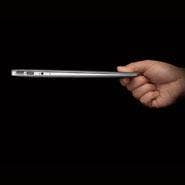New MacBook Air Maintains Apple's Heavyweight Status In Notebooks

Apple refreshed its MacBook Air line of notebook computers Tuesday, introducing new 11-inch and 13-inch models that eliminate hard disks and optical drives in favor of solid-state flash data storage.
Apple also offered a sneak peak at Mac OS X Lion, the next release of the Mac operating system that's slated to ship next summer.
While most of Apple's attention seems to have been focused on its iPhone and iPad devices in the past year or so, the debut of the MacBook Air shows that the company isn't ignoring the notebook computer market.
By replacing mechanical hard disks and optical drives with flash storage in the new MacBook Air notebook computers, Apple is taking the same approach it does with its popular iPad device, which only uses solid-state storage technology. Apple said solid-state flash storage is up to twice as fast as hard drives, is more reliable and is as much as 90 percent smaller and lighter than hard drives.
Apple said the new MacBook Air was designed from the ground up to solely use flash storage. "MacBook Air is the first of a new generation of notebooks that leaves behind mechanical rotating storage in favor of solid-state flash technology," said Apple CEO Steve Jobs in a statement. "We've taken what we learned with the iPad: solid-state storage, instant-on, amazing battery standby time, miniaturization and lightweight constriction to create the new MacBook Air. With its amazing responsiveness and mobility, it will change the way we think about notebooks."
NEXT: MacBook Air Specs, Mac OS X Lion
The upgraded MacBook Air is 0.68 inches at its thickest point and comes in two flavors: an 11-inch model that weighs 2.3 pounds and a 13-inch model that weighs 2.9 pounds. They feature a full-size keyboard and the same glass Multi-Touch trackpad used on the MacBook Pro. They also include a built-in FaceTime camera, microphone and stereo speakers. Apple said the notebooks offer up to seven hours of battery life and up to 30 days of standby time.
The new notebooks use Intel Core 2 Duo processors and Nvidia GeForce 320M graphics chips. They sport 11.6-inch or 13.3-inch LED-backlit displays, 802.11n Wi-Fi networking, Bluetooth 2.1+EDR for wireless peripherals and two USB ports. The 13-inch model also has an SD card slot.
Both models are available immediately. Pricing for the 11-inch MacBook Air with 2 GB of memory and 64 GB of flash storage starts at $999 while a 128-GB model is priced at $1,199. Pricing for the 13-inch MacBook Air with 2 GB of memory and 128 GB of flash storage starts at $1,299 while a model with 256 GB of flash has a price tag of $1,599.
The new MacBook Air runs on Apple's Mac OS X operating system, putting to rest speculation that Apple might abandon Mac OS X in favor of the iOS that runs the iPad.
But the upcoming Mac OS X Lion (Mac OS X 10.7), which Apple previewed Wednesday, does incorporate elements from the iPad operating system. The software will include Mac App Store for finding, installing and automatically updating applications; a Launchpad feature, similar to iPad's home screen, which Apple said will make it easier to find and launch any application; and a Mission Control feature that offers a unified view of all windows and apps running on the Mac. Mac OS X Lion also provides systemwide support for apps that run in full-screen mode and makes more advanced use of multitouch gestures.